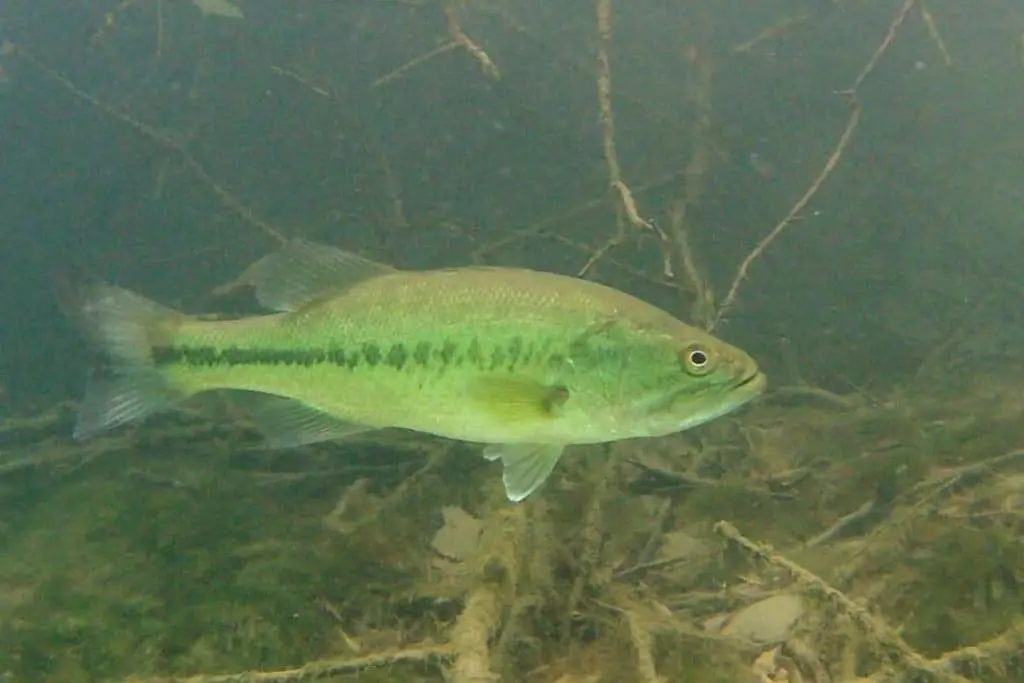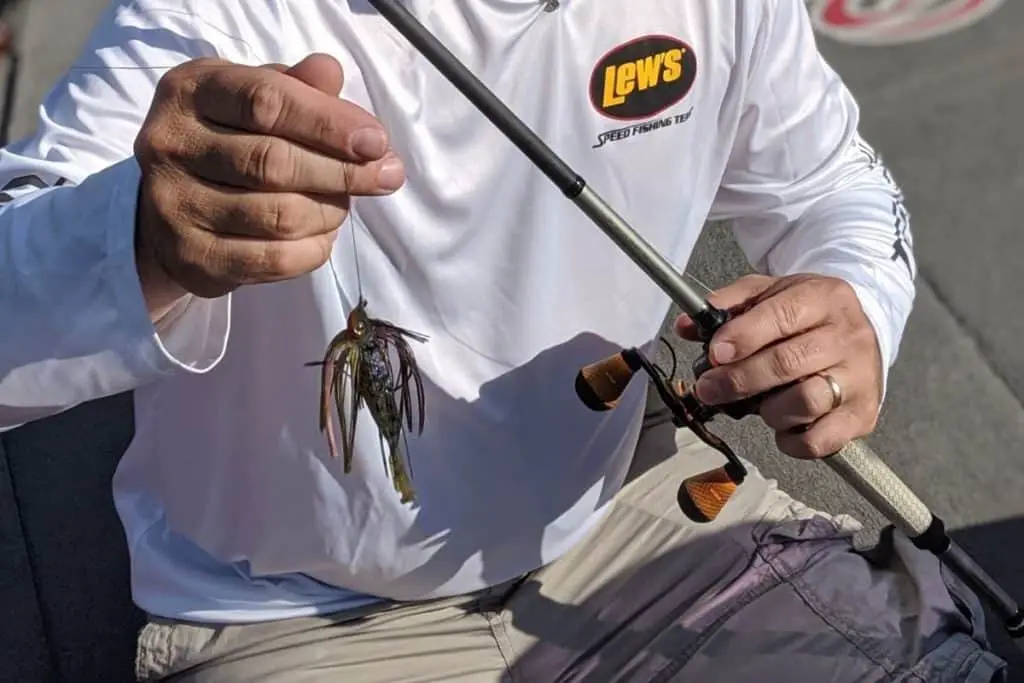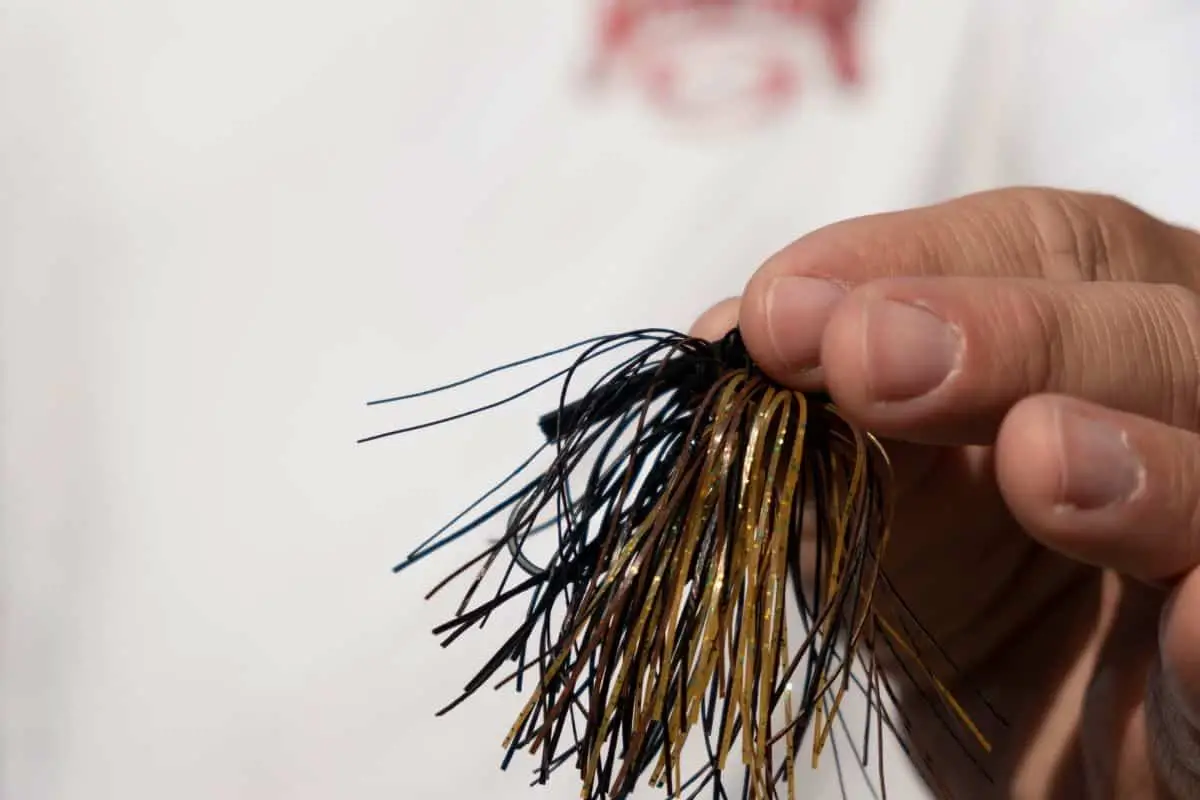Jigs catch bass and lots of them. They are best suited for heavy cover and because of this, having the proper gear ratio reel is a critical part of the presentation.
A reel in the 8.3:1 or 7.5:1 range will allow anglers to get the bass coming to them and not turn and bury up in the cover. High-speed gear ratio reels will significantly enhance the number of bass an angler lands.
Breaking down why these gear ratios are best for bass fishing with a jig will help anglers understand the benefits and efficiency.
Bass Jigs and Heavy Cover
It is not a surprise that bass love to hide in heavy cover.
The gnarliest brush piles, the thickest weeds, and the most complex docks offer lots of places where schools of bass can hide and keep a keen eye out for prey.
Bass are able to sit motionless and still pull water through their gills to breathe. Not all fish can do this. The nature of their physical makeup is what allows bass to hide in such thick places.
A jig may be the perfect tool to probe those locations.

The First Second is Critical When Fighting a Bass on a Jig
When an angler feels that tell-tale thump on the end of the line, the next second can determine whether or not that bass is going to successfully be pulled from the heavy cover or come loose.
The quick line recovery that a high-speed gear ratio reel offers will help a bass angler to keep the head of the fish coming toward them. This is the critical moment in the landing process.
If that bass is able to turn its head and swim deeper into the brush or weeds, the odds of it getting wrapped up and pulling off the jig are quite likely.
The below table demonstrates how much more line recovery per turn a high-speed reel has.
| Gear Ratio | Inches of Recovery Per Turn (RPT) |
| 5.1:1 | 21″ |
| 6.2:1 | 25″ |
| 7.5:1 | 31″ |
| 8.3:1 | 35″ |
Other Important Factors When Jig Fishing Heavy Cover
Besides a high-speed reel, there are three other important factors to up the odds of success.
Drag Setting for Jig Fishing
When fishing bass jigs in heavy cover it is best to have the drag cranked almost all the way up.
Why?
Once again, the goal is to keep the head of the bass coming out of the thick cover. A tight drag will help ensure this happens. If there is too much slip on the drag when jig fishing an angler may not get good hook penetration. The fish is likely to pull enough line it can dive deeper into cover and come off.
Line Choice When Jig Fishing
Using a low-stretch or no-stretch line is another key component to successful jig fishing with high-speed gear ratio reels.
A line like monofilament has a lot of stretch in it. Braid and fluorocarbon do not and offer the best odds of bringing the fish to the boat.

Rod Choice When Matching With a High-Speed Reel
Choosing the proper jig rod to pair with that high gear ratio reel is also an important step.
Selecting a jig rod with a medium-heavy or heavy power rating and a fast action will once again keep the fish from turning and heading deeper into cover.
A good jig rod paired with a low-stretch line will also transfer much more energy to the hookset than a rod with too much parabolic action.
(Here is an article on what trailer to put on a jig.)
High-Speed Reels Mean More Casts
Another added benefit of using a high-gear ratio reel when jig fishing for bass is the line recovery.
As the above table shows, there is a substantial difference between a low speed and a high speed reel. When the initial presentation is over an angler is able to get that jig back to him or her and present it again much quicker with a high gear-ratio reel.
At the end of a day of fishing this will translate to many more casts, which means more opportunities, which will end up with more fish caught.
Hitting a key piece of cover three or four times because of quick line recovery is much more likely to put that jig in front of your next personal best.
What About Gear Ratios for Swim Jigs and Bladed Jigs?
I fish a bladed jig very similar to a flipping jig when dragging it on the bottom.
I like to pop the bladed jig, let that blade vibrate and then sink back down. The more short hops – the better.
With this type of bladed jig, or Chatterbait, retrieve using the same high-speed gear ratio reel is the best choice. The same principles apply here. When that bladed jig is a distance from the boat or shore transferring maximum energy to the hookset is important. Line recovery gives the angler the chance to eliminate any slack before that hook is hammered home.
Swimming Retrieve with Jigs
When swimming a bladed jig, or using a swim jig, then moving to a gear ratio that is a little slower will benefit the angler.
Bass anglers tend to fish too fast.
Choosing a reel in the 6.2:1 range will keep those swimming retrieves slower and under control. Using a high-speed reel will work, but a conscious effort needs to be made to keep the presentation slow. Pulling in nearly 3ft of line each time the handle is turned translates to a lure moving through the water column at an incredible rate.
Final Thoughts
Proper reel selection for the lure and presentation directly correlates to more angler success.
When fishing a bass jig, keeping a high-speed reel on the rod will bring more fish to the boat and result in less angler frustration.
Be safe and make sure to encourage someone today. You never know how you may change their life forever.
Isaiah 6:8

